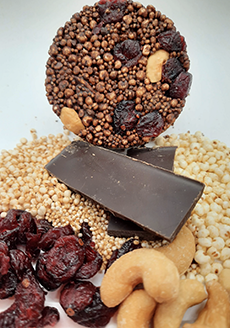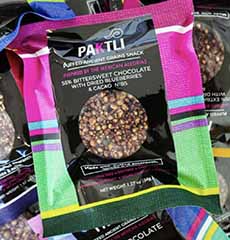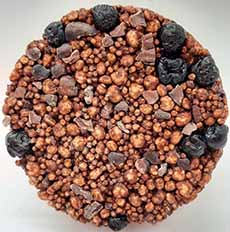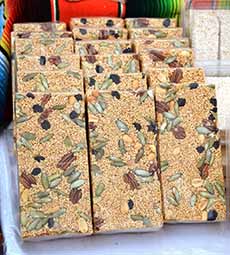Paktli Puffed Ancient Grains Snacks
|
One of the rewards of walking up and down long aisles at food trade shows is that you sometimes come across something totally unexpected. That was the case with Paktli Snacks, made from puffed ancient grains that are gluten-free (photos #1 through #4). Our review is below, but first, some background. The Aztec culture revered amaranth, a grain that thrives in hot temperatures and is largely resistant to drought. It was thus both tasty and reliable; crops were less likely to fail. It was a staple food along with beans, corn, and squash [source]. The Aztec name for amaranth was paktli, which means joy in the Nahuatl language. In prehispanic times, in addition to being a diet staple, amaranth was also used as currency and for ceremonial purposes. In the Aztec diet, amaranth, a native Mexican cereal grain, was second only to corn (another native cereal grain) in importance. Every part of the plant is edible, but the Aztecs most valued the tiny seeds, which are even smaller than quinoa seeds. Like quinoa, amaranth is packed with essential amino acids. It also has twice the iron content of wheat. As with corn, amaranth grains were toasted and eaten whole, boiled into porridge, or ground into flour to make tortillas and tamales. During the holy month of Panquetzaliztli (analogous to December), toasted amaranth grains were mixed with honey into a dough called tzoalli, which in turn was shaped into idols of Huitzilopochtli, the sun and war god, and other deities. The idols were paraded through the streets and displayed in the temple before being “sacrificed”; priests broke the candy statues into tiny pieces and distributed them among the crowd. In Spanish, alegría is the word for joy—i.e., the Spanish word for paktli. In Mexico, puffed amaranth is mixed with honey or sugar and served like a Rice Krispie treat. It’s a specialty of the town of Santiago Tulyehualco in the Xochimilco borough of Mexico City. It’s been known as alegría since the 16th century [source]. In September 2016, the treats from Santiago Tulyehualco were officially declared Patrimonio Cultural Intangible de la Ciudad de México (an intangible part of the cultural heritage of Mexico City). Alegrías have become the most popular way of consuming amaranth. The amaranth grains are puffed in a hot pan without oil, then mixed with honey or sugar syrup. Pepitas (pumpkin seeds), nuts, and dried fruits are popular additions. Rectangular bars and rounds are typical shapes (photo #5). Paktli Foods’ puffed grain snacks are inspired by Mexican alegrías. In addition to amaranth, millet and quinoa are added to the snacks. The grains are mixed with high-quality organic ingredients including chocolate, dried fruits, and nuts. The result is an all-natural, tasty, gluten-free, and may we add fun, snack. The use of sugar is sparing; i.e., the snacks are not particularly sweet (just sweet enough), with 8g added sugars. They have 4g of protein. They are a delicious, healthier accompaniment to coffee, tea, and cola, instead of that cookie or candy bar. Disks of 2-1/2 inches in diameter are made in: Are you ready to take a bite of the modern version of an ancient snack? Head to PaktliFoods.com. |
|
|
|
CHECK OUT WHAT’S HAPPENING ON OUR HOME PAGE, THENIBBLE.COM.
|
||







